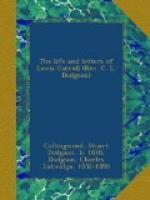Say, whose is the skill that
paints valley and hill,
Like a picture
so fair to the sight?
That flecks the green meadow
with sunshine and shadow,
Till the little
lambs leap with delight?
’Tis a secret untold
to hearts cruel and cold,
Though ’tis
sung by the angels above,
In notes that ring clear for
the ears that can hear,
And the name of
the secret is Love!
That “secret”—an open secret for him—explains this side of his character. As he read everything in its light, so it is only in its light that we can properly understand him. I think that the following quotation from a letter to the Rev. F. H. Atkinson, accompanying a copy of “Alice” for his little daughter Gertrude, sufficiently proves the truth of what I have just stated:—
Many thanks to Mrs. Atkinson and to you for the sight of the tinted photograph of your Gertrude. As you say, the picture speaks for itself, and I can see exactly what sort of a child she is, in proof of which I send her my love and a kiss herewith. It is possible I may be the first (unseen) gentleman from whom she has had so ridiculous a message; but I can’t say she is the first unseen child to whom I have sent one! I think the most precious message of the kind I ever got from a child I never saw (and never shall see in this world) was to the effect that she liked me when she read about Alice, “but please tell him, whenever I read that Easter letter he sent me I do love him!” She was in a hospital, and a lady friend who visited there had asked me to send the letter to her and some other sick children.
And now as to the secondary causes which attracted him to children. First, I think children appealed to him because he was pre-eminently a teacher, and he saw in their unspoiled minds the best material for him to work upon. In later years one of his favourite recreations was to lecture at schools on logic; he used to give personal attention to each of his pupils, and one can well imagine with what eager anticipation the children would have looked forward to the visits of a schoolmaster who knew how to make even the dullest subjects interesting and amusing.
Again, children appealed to his aesthetic faculties, for he was a keen admirer of the beautiful in every form. Poetry, music, the drama, all delighted him, but pictures more than all put together. I remember his once showing me “The Lady with the Lilacs,” which Arthur Hughes had painted for him, and how he dwelt with intense pleasure on the exquisite contrasts of colour which it contained—the gold hair of a girl standing out against the purple of lilac-blossom. But with those who find in such things as these a complete satisfaction of their desire for the beautiful he had no sympathy; for no imperfect representations of life could, for him, take the place of life itself, life as God has made it—the babbling of the brook, the singing




